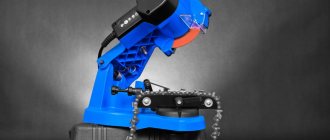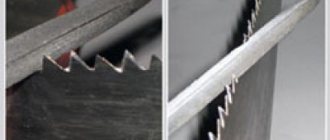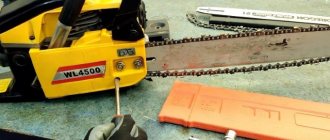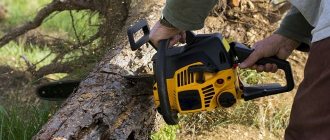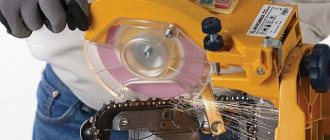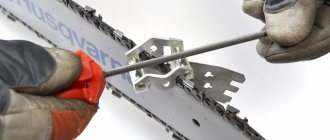How it is done sharpening chains for electric saws? Ways. Advantages and disadvantages. Read on to avoid making common mistakes!
Every saw requires maintenance - the most common problem is the saw getting stuck in the wood. This is dangerous and fraught with consequences.
There is no need to throw away the chain; sharpening chains for electric saws solves everything. However, if this is done incorrectly, uneven pressure is applied to the tire, which means it wears out in places where it is used, the internal groove breaks and the tail burns. The problem should not be ignored - you risk damaging the sprockets.
If the sawdust has changed shape and consists of fine dust, it’s time to find out how to properly sharpen a power saw chain, how much it costs, and what methods professionals offer.
When should the work be done?
When using a chainsaw intensively, sharpening is carried out quite often, often several times in one day. Particular attention should be paid to the fact that the contact of the chain with the ground significantly speeds up the process. Therefore, chainsaws must be used in such a way as to eliminate the possibility of contact between the chain and the ground. After several contacts, the chips will be very small, and the chain will go deeper into the material slightly. When considering this issue, it can be noted: the more often you have to sharpen the chainsaw chain, the less metal layer is removed. Also, if you sharpen frequently, the service life of the cutting element of the chainsaw will increase significantly. The main condition can be called the correct execution of the work, if you do it yourself. The procedure can only be performed correctly if you have a special machine. A sign that the cutting element of a hand chainsaw has become dull is a significant feed force. Properly sharpened chains determine a significant reduction in the feed force, that is, the chainsaws enter easily with a little pressure. Another sign of the need to sharpen chains is the production of very small chips. Sharpening a chainsaw when the signs in question appear is mandatory. Sharpening of chains is carried out in order to greatly reduce the tension in the body, reduce the cyclic load rate and fuel consumption. Also, if you do not sharpen the teeth of the chains on time, there is a possibility of increased wear of all components, as a result of which the service life of the hand chainsaw is reduced.
How to sharpen a power saw chain: videos and advice from professionals
Our clients and partners have sharpened chains more than once, and they always share excellent life hacks. The most important thing is to consider the following factors:
- Sharpen the chain starting with the worst tooth, because... it should not be shorter than others
- Make sure that the limiting tooth is always lower than the cutting tooth (but not completely ground down!)
- Always pay attention to the Hard and Soft marks: the first is for work in winter (dry wood), and the second in summer (wet wood)
- Sharpen all the teeth of the chain at once so that it works smoothly
- Sharpening angle of chain for electric saw: 10 for longitudinal cutting, 30 for cross cutting
See how to extend the life of a chain after sharpening:
If you don't have the resources and time, be sure to find out where to sharpen your electric saw chain in your city. Professionals will do it quickly, efficiently and inexpensively!
Geometry Features
In order to sharpen correctly with your own hands, even if you use a machine, you should know the geometry of the tooth. Its constituent elements include:
- Spatula.
- The main link.
- Depth limiter.
In this case, the tooth blade consists of the following elements:
- End blade.
- Top blade.
You need to sharpen correctly with your own hands, taking into account the fact that the end and top blades must be positioned correctly relative to each other to ensure the best cutting performance. The back of the tooth forms a certain angle of the upper blade. A similar angle is formed to cut the blades into the material. Sharpening with your own hands should also take into account the fact that the blade has a narrowing towards the back - this design feature forms the angle of the end blade. It is created to ensure lateral cutting of chips.
Chainsaw chain tooth
The sliding surface and the end part of the blade forms the rake angle. In this case, the angle has a fixed value; it varies from 60 to 85 degrees. If you sharpen the teeth with your own hands, it is worth considering that the upper blade is the main one, and the angle formed by it is the most important angle. To summarize, when considering the issue of geometry features, we note that the sharpening angle can vary depending on the conditions of use. The basic rule that should be followed when sharpening a tooth with your own hands is the following: the higher the angle, the greater the performance of the chainsaw, but reducing the value ensures smoother running of the blades, reduced vibration and increased service life. It is worth sharpening taking into account that the indicator should be in the range from 25 to 35 degrees. An exception is the version of the blade, which is intended for longitudinal cutting - many manufacturers of the chainsaw cutting element can withstand 10 degrees.
Sharpening rules
To properly sharpen a chain at home, you need to know and follow a few simple rules:
- It is possible to maintain the sharpening angle of the cutting part of an electric saw only with the help of a device or machine;
- When sharpening with a file, the number of its movements along the cutting edge should be the same for the entire cutting part;
- The file is used only for editing (sharpening cutting elements that are not very dull);
- The rotation speed of the sharpening machine disk should be minimal (ideally 0.5-1.0 thousand rpm);
- The file moves only forward;
- When the length of most teeth is ground down by more than 90%, the cutting element is disposed of;
- If the chain tooth is ground down by more than 50%, the height of the feed stop can be ground down by 0.5 mm; until this point, the feed stop cannot be ground down.
The last two points require a little clarification. When grinding down the length of a tooth by more than 90%, there is a high risk of it breaking during operation. If this occurs, the operator will feel a strong jerk forward, which may cause him to fall onto the running saw. The same thing can happen when grinding down the height of the feed stop - the tooth will cut into the wood very deeply, the chips will not chip and the saw will be pulled forward.
Saw design
To better understand what a chainsaw is and how it works, it is advisable to know how it works.
By the way, it would be more correct to call the cutting tool of a chainsaw a saw chain.
The first saw chains appeared at the beginning of the twentieth century. The designers did not begin to puzzle; they simply mounted teeth on the chain, which quickly lost their functionality. In appearance they resembled those that stand on hand hacksaws for wood. Sharpening such a chainsaw caused great difficulties. But repeated attempts to create the perfect saw chain were crowned with success only in 1947.
Chainsaw device
This chainsaw has links with an L-shaped cut. Modern chains are, in fact, the direct ancestors of this development.
If during work the cutting speed begins to decrease, the chainsaw in the hands of the master begins to “walk”, then most likely the saw chain has lost its operational properties, that is, it has become dull and measures must be taken to restore them.
Why does the tool become dull?
Each chainsaw has a certain durability period. This is the time from the start of work with a new tool until it becomes inoperable.
Destruction or wear of a cutting tool intended for woodworking occurs due to the impact of a set of forces arising during the cutting process. One of the key ones is friction force. Dulling of the saw chain occurs due to prolonged work, due to the use of a chainsaw for purposes other than its intended purpose.
The amount of wear can be defined as a measure of weight, measured in milligrams. Wear is a parameter that shows a change in the characteristics of the shape and size of the cutting blade. The change in geometric parameters that occurs during cutting, and there is no linear wear, is called blunting.
There are parameters on the basis of which a decision is made about the possibility of further operation of the tool. In particular, when examining the teeth of a saw chain, it is necessary to pay attention to the edges of the front and rear surfaces, the height of the blade, and the wear area. If they are in unsatisfactory condition, it means it’s time to sharpen the chainsaw.
Signs that the saw has lost its sharpness include the following:
- Reducing chip size.
- Using more force to do the job.
Which chain sharpening machine is better to choose?
The Russian market offers a large selection of sharpening instruments from different manufacturers; they differ in price, technical purpose and parameters. However, not every manufacturer offers guaranteed tool quality. Based on expert opinion and numerous user reviews, a rating was compiled that included companies that offer the best chain sharpening machines.
- Rezer – belongs to . Produces a wide range of consumables, spare parts and accessories for garden equipment. Consumables and accessories for chain saws are a priority area of production; they are suitable for different brands of electric chain saws and chainsaws.
- Diold is a Russian manufacturing company that has been supplying the market with a large selection of power tools for over 15 years. Provides stable prices for all products, offers high quality, and uses a competent approach to serving users.
- Whirlwind is a recognized authority in the production of power tools and pumping equipment. Supplies a good selection of hand-held units for DIYers and professionals. All equipment undergoes strict quality control, which makes it possible to provide a long-term guarantee and stable operation under high loads.
- Huter produces a wide range of power tools and garden equipment. The trademark was registered in 2004 and has earned the trust of consumers. All products undergo multi-stage control and meet international quality standards.
- Patriot - occupies a leading position in several categories simultaneously: power tools, garden and power equipment. Offers modern developments, innovative technologies, taking into account the needs of each customer.
- Champion is one of the most popular Russian manufacturers of portable garden and power equipment. Constant growth of capacity, decent quality and a well-coordinated team of professionals. The main advantage is affordable prices for all equipment, including the professional series.
- Caliber - produces a wide selection of tools in the segment from budget to premium class. All equipment and equipment is manufactured using modern equipment and undergoes strict quality control.
- Soyuz – produces a wide selection of electrical equipment, equipment, consumables and accessories. A feature of the brand is the high quality, durability of the devices, and a guarantee. One of the advantages of Soyuz brand equipment is its high maintainability rate.
- Dnipro - M - the best Ukrainian manufacturer produces a wide selection of diverse garden machinery, equipment and power tools. For several years, the brand’s equipment has enjoyed popularity and authority among home and professional craftsmen. Today the company has more than 22 service centers.
- Spets is a well-known Russian company that represents more than a hundred types of products. All machinery, power tools and power equipment meet international quality standards. The quality of components, assembly technology and a stable combination of price and quality make the brand’s products one of the top leaders in the Russian market.
When to sharpen and how to find out about it
After examining the saw chain, the master decides whether it is time to sharpen the tool or not.
As a rule, the saw chain loses its performance properties during intensive work. It can get to the point where the chain will have to be sharpened several times in one day. The cause may also be contact of the saw with the ground. In fact, just scrape the saw chain across the ground a few times and you can stop all work. The chainsaw will simply stop going into the tree. By the way, one of the signs of a dull saw is the appearance of small chips.
Dull chainsaw chain
The sooner measures are taken to sharpen the chain, the longer it will last. It is quite easy to understand when resharpening is required. There will be a feed change. A chain with properly sharpened teeth will retract even with a small force, but if during operation you have to exert a greater feeding force, then this means only one thing, the teeth have lost their sharpness.
Do not use a blunt chain. By the way, this is a safety requirement. And the process will require significant muscular effort from the lumberjack. As a result, this leads to a decrease in cut quality, an increase in the amount of fuel used and accelerated chain wear.
Why do you need to sharpen a chainsaw chain?
However, the chainsaw must be sharp, since a dull chain of the tool leads to the following consequences:
- Reduced efficiency of wood cutting. Instead of several trees, a dull chainsaw chain will cut down only 1 in the same period of time.
- Increased load on the chainsaw mechanism. The drive sprocket and tire wear out faster.
- Fuel consumption increases. A dull chain requires more force to cut wood.
- The cuts are uneven with a lot of jagged edges.
File
A file can be used to carry out the work in question. A file is used to remove the required layer of metal from the surface. A special set was created for this case:
- The file is round and has an unusual holder.
- Flat file needed to adjust the depth limit.
- Hook.
- Special template.
The round file holder is created along with marking lines that are used to position the tool correctly. During operation, the plate itself comes into contact with the depth stop and the surface of the blades, and the file moves around and removes a layer of metal. The use of a special holder with a file allows you to ensure the correct fit of the tools to the surface being processed. You should only use a file that is designed to perform such work.
Angles of inclination when sharpening with a file
The rules of work include:
- The same number of movements should be done.
- It is necessary to control the force of pressure on the surface during processing.
- The template, which is used together with the file, allows you to maintain important sharpening parameters.
With different lengths, uneven travel and the formation of cracks in the material are observed. If the length indicator is not the same at the start of processing, then all cutting teeth are filed according to the indicator of the smallest one.
Sharpening a chainsaw chain with a file
Professionals remind you that all chainsaw teeth have a specific structure. It is worth figuring out which part of the tooth needs to be sharpened, and which side should not be touched. After sharpening, the teeth should look as close as possible to the factory one.
Otherwise the tool will not work properly. Each tooth needs to be ground for the same amount of time to maintain symmetry.
For chains with a diameter of 1.3, it is recommended to use a file with a diameter of 4 mm. Chains with a diameter of 1.6 are sharpened with a 5.2 mm file. To sharpen the stopper you will need a flat file. Before starting work, you must wear gloves to protect your hands from the sharp teeth of the chainsaw. The chain must be tensioned during sharpening.
Stages of sharpening a chain with a file:
- Clamp the chainsaw bar in a vice. A stationary tool will not interfere with sharpening.
- It is necessary to mark with chalk the tooth from which sharpening begins. Otherwise, you will be able to walk in circles, wasting extra time on the procedure.
- Place the clamp and file at a 30 degree angle to the chain.
- Using light movements, you need to sharpen the teeth of the chainsaw chain on your own. With a new file, 7 passes are enough to sharpen the chain teeth.
- Having sharpened all the teeth on the right side, you need to turn the chainsaw around and sharpen the left teeth.
“Pros” of sharpening a saw with a file: sharpening can be done in the field without much labor or tools. Among the “disadvantages” of this sharpening method: the process is labor-intensive and time-consuming.
A good sharpening file is required. Cheap tool options will quickly fail after the first run through the chain. If the chain is too dull, using a file will not correct the situation. Alternative sharpening options need to be considered.
Application of special machines
It is not always possible to use a hand tool with a template. For example, if the cutting edge comes into contact with the ground during operation, there is a possibility of its deformation. In this situation, a special machine is used. The machine comes in two types:
- Mechanical.
- Electric.
The power saw has a design that looks like a bow saw, but with a round file. The machine can be used to level the length of all edges and restore the correct geometry. The machine in question has a complex system for setting processing parameters. Sharpening is performed in approximately 2-3 movements, after which the machine is installed in a new location.
The electric machine is easy to use. A special adjustment system allows you to correctly position the surface to be treated, as well as position the disc with high accuracy. Some models have an automatic vice clamping system when the disk is lowered. The cost of the electric version is slightly higher, but at the same time the performance increases significantly and the most accurate result can be achieved.
PDF Guide to Sharpening Stihl Saw Chains
Electric semi-automatic
Electrically driven sharpeners are popular due to their high productivity and sharpening quality.
As a rule, such devices are used by specialized service centers that provide paid services for editing and sharpening. With the advent of household models of sharpeners, which are distinguished by reasonable prices, they have become popular among saw owners.
Advantages of an electric sharpener:
- High sharpening speed.
- Possibility of aligning the working tooth (when sharpening by hand, the teeth of the chain are not ground down evenly).
- Ideal sharpening angle and the ability to adjust it.
- Full or partial automation of the process.
- The ability to connect from both a 220 and 12 volt network, thanks to which you can use a car battery as a power source, which is quite convenient.
The disadvantages of an electric machine for sharpening chains include the need to connect to a power source, which is not always possible if it is necessary to sharpen the headset in a plot or during logging.
Using an electric sharpener requires certain skills from the operator. For example, an incorrectly set grinding depth can lead to the working teeth overheating during the sharpening process and then losing their properties. The metal becomes soft, does not hold an edge, and the teeth become dull easily during operation.
Another downside is that during operation, the grinding wheels gradually wear out and need to be replaced, which increases the cost of owning the unit.
To avoid grinding off the wheels, you can use special diamond grinding discs of a suitable size. The service life of such discs is several times greater than the service life of a conventional grinding wheel.
Design and principle of operation
A saw chain sharpening machine consists of several elements. The base is a frame that is used to mount the motor and a vice with guide rails for the chain. The motor is usually asynchronous with high speed and direct transmission. A sharpening disc is installed on the motor shaft and secured with a guide washer and nut.
The place where the engine is attached to the frame is movable, thanks to this scheme it is possible to adjust the position of the engine in space, which is necessary to set the correct sharpening angle.
A vise with a slide is designed to install the chain and hold it. A limit plate with the ability to adjust the depth of cut is attached to the vice. By turning the adjusting screw clockwise, the plate extends and the sharpening depth increases.
The operating principle of the sharpening machine is extremely simple:
- The chain is installed in the guide slide, the stop is lowered and rests against the back of the tooth being sharpened, preventing it from moving.
- After this, the engine with the disk installed on it is lowered. The disc touches the tooth and grinds down its edge.
- Next, the operator moves the chain to the next tooth and installs the stop bar, after which the process is repeated.
In practice, the principle of operation is a little more complicated, because before you start sharpening, you need to set up the machine. Setting instructions can be found in the documents for the sharpening device.
You can learn more about the operating principle of a semi-automatic chain sharpening machine by watching a video demonstrating operation of the VIHR SZTs-200 machine.
How to properly sharpen a chainsaw chain with your own hands. Step-by-step instruction
Bringing a chain into working condition has its own characteristics. They are determined by the configuration of the tooth. It includes two edges, located - one at the top and the other at the bottom. Moreover, the edge located towards the top has a slope at a given angle. In fact, the tooth, both in geometry and in its operating principle, is similar to the blade of a carpenter’s plane.
Manual chain sharpening diagram
For competent sharpening, the master must understand the structure of the tooth.
Teeth parameters
The tooth structure consists of:
- grounds;
- shoulder blades;
- limiter.
Two cutting edges are formed on the blade, one is placed on a horizontal plane, the other at an angle. To obtain the required parameters, the blades are sharpened at the angle specified in the technical specifications. The rake angle is sharpened in the range from 60 to 85 °.
The clearance angle indicates the backward tilt of the upper blade. It lies in the range of 50 to 60°. The blade located on top is considered the main one; the rear angle in this design is very important. It is difficult to measure; if the sharpening rules are followed and the geometric parameters are observed, it is formed in the specified range.
Teeth
The corners are sharpened depending on the use of the tool. The main rule is that the larger the angle, the greater the efficiency when processing soft wood; the smaller the angle, the easier it is to operate the saw with hard wood. That is, the smoothness of operation improves and the vibration of the tool decreases.
Meanwhile, the situation of sharpening the angle greater than 35 and less than 25° should be avoided. This rule does not apply to rip chains.
The angles change when editing the tool. They have an important impact on cutting parameters, so all technical requirements must be carefully followed.
What are the dangers of working with a blunt instrument?
The chain of an electric or gasoline saw is designed for sawing hard and soft wood and plastic products. When the tool is used regularly, the chain mechanism becomes dull, which can lead to unpleasant consequences. A worn chain mechanism puts you at risk of breaking individual elements of the entire tool. When sawing with a dull chainsaw, fuel consumption increases.
Additional Information! When using a dull chainsaw, the process of sawing any materials takes longer, and productivity drops noticeably.
To maintain the functionality of the saw for a long time, the chain mechanism should be inspected and sharpened in a timely manner. The check should be carried out between jobs depending on the frequency of use of the tool.
Tips and tricks on how to sharpen a chainsaw at home
It is permissible to use a file for sharpening, but you must understand that such operation of the saw will require certain skills and, of course, patience from the master. To sharpen each tooth, you need to have flat and round needle files on hand. To sharpen a tooth, without using additional equipment, it is necessary to maintain the basic sharpening inclination. Only 2-3 passes with a file are enough for sharpening, so there is no point in inventing some kind of equipment to fix the tooth in a certain position. To sharpen the top edge, the file must be held at the required angle while working. Restoring operability begins with preparation, namely, from the working edges; it is necessary to remove all nicks.
If everything is clear with the angles of the teeth with straight parts of the structure, then the edge located on the side and its working inclination cause certain difficulties. To straighten them, you need to use a round file or a small file. These tooth elements are sharpened at the required angle.
Sharpening on a machine
If sharpening work is carried out quite often, then it is necessary to use special equipment and technological equipment (templates). Using a template on a device of this type allows you to complete this work much faster. Such a device can be a wooden block of small size. This type of template should allow sharpening at two angles. Sharpening can be done using a small diameter grinding wheel or an emery belt that can be mounted in place of the belt drive.
Chainsaw chain sharpening machine
Sharpening a chainsaw chain with a machine
Machines of this type, masters, can be made independently, using the drive from a foot-operated sewing machine as the basis for the design. Using a belt drive and a template, it is possible to process one cutting edge and then another.
Methods for sharpening a saw chain
Whatever the sharpening method, its main task is to sharpen the teeth of the cutting element of the electric saw, while maintaining the sharpening angle. The difficulty of the task lies in the large number of teeth themselves located on the cutting element, while the sharpening angle of one half of the teeth is directed to the left of the operator, and the other to the right. For high-quality sharpening of teeth, the sharpening device must be rotated 180˚. There are two main ways to sharpen the cutting elements of electric saws: sharpening with a file, sharpening with a machine. The third method is to sharpen the cutting element using an angle grinder (angle grinder), often called a “grinder”. However, if we take into account that sharpening is carried out using an electric motor of an angle grinder, then it is more logical to classify it as “sharpening by machine”.
Sharpening with a file is a manual method, the most difficult and time-consuming. Its main value is independence from energy resources. It is used far from electrical networks or for quick, corrective sharpening of a cutting part that is not very dull.
The file for sharpening electric saw chains used in this method should be round, with a fine and medium cut. To maintain the sharpening angle, the file must be used in conjunction with a guide device. Both when sharpening on a machine and when working with a file, the result should be a sharp, shiny, cutting edge.
Sharpening a chain on a machine is the easiest and fastest way. Its advantages are the speed of work and the ability to restore the sharpness of any cutting part, even a very dull one.
Technical features of the sharpening process
The sharpening operation is complicated by the fact that the teeth have a large number of cutting edges located in different planes and having different sharpening angles. When sharpening teeth, it is necessary to make the same amount of movement, and it is necessary to withstand the same pressure force. As a result, all teeth will receive the same type of sharpening.
Also, if the saw chain is sharpened more than 4 or 5 times, then the depth stop must be reduced.


